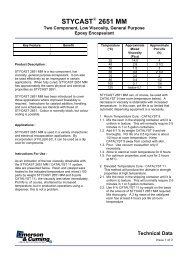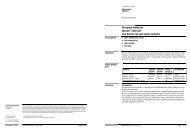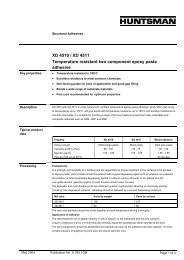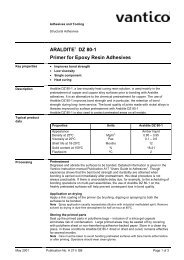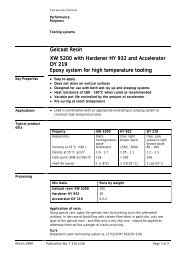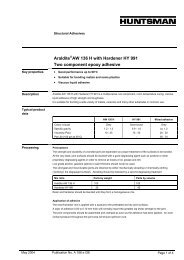XW 1038 Resin with XW 1015-1 Hardener Two component epoxy ...
XW 1038 Resin with XW 1015-1 Hardener Two component epoxy ...
XW 1038 Resin with XW 1015-1 Hardener Two component epoxy ...
You also want an ePaper? Increase the reach of your titles
YUMPU automatically turns print PDFs into web optimized ePapers that Google loves.
Adhesives and ToolingStructural Adhesives<strong>XW</strong> <strong>1038</strong> <strong>Resin</strong> <strong>with</strong> <strong>XW</strong> <strong>1015</strong>-1 <strong>Hardener</strong><strong>Two</strong> <strong>component</strong> <strong>epoxy</strong> paste adhesive for composite andmetal bondingKey properties • Temperature resistant to >100°C• Excellent resistance to most common chemicals• Non flowing paste for ease of application• Gap filling• Cold or warm curingDescription<strong>XW</strong> <strong>1038</strong> / <strong>XW</strong> <strong>1015</strong>-1 is a two <strong>component</strong>, non slumping paste adhesive, cold or warm curing, impact resistant,<strong>with</strong> excellent resistance to water, solvents and chemicals. It is suitable for bonding a range of ferrous metalsand aluminium alloy substrates and polymeric substances such as GRE, ABS and SMC, for applications suchas composite pipe bonding as well as general industrial applications.Typical productdataProperty <strong>XW</strong> <strong>1038</strong> <strong>XW</strong> <strong>1015</strong>-1Colour (visual) white paste grey pasteSpecific gravity ca. 1.45 ca. 1.65Viscosity at 25°C (Pas) thixotropic thixotropicFlash point (°C) >200 >100ProcessingPretreatmentThe strength and durability of a bonded joint are dependant on proper treatment of the surfaces to be bonded.At the very least, joint surfaces should be cleaned <strong>with</strong> a good degreasing agent such as acetone,trichloroethylene or proprietary degreasing agent in order to remove all traces of oil, grease and dirt.Alcohol, gasoline (petrol) or paint thinners should never be used.The strongest and most durable joints are obtained by either mechanically abrading or chemically etching(“pickling”) the degreased surfaces. Abrading should be followed by a second degreasing treatmentMix ratio Parts by weight Parts by volume<strong>XW</strong> <strong>1038</strong> 100 100<strong>XW</strong> <strong>1015</strong>-1 50 44<strong>Resin</strong> and hardener should be mixed together at room temperature stirring thoroughly.Application of adhesiveThe resin/hardener mix is applied directly or <strong>with</strong> a spatula, to the pretreated and dry joint surfaces.A layer of adhesive 0.05 to 0.10mm thick will normally impart the greatest lap shear strength to the joint.The joint <strong>component</strong>s should be assembled and clamped as soon as the adhesive has been applied. An evencontact pressure throughout the joint area will ensure optimum cure.August 2000 Publication No. A 304 c GB Page 1 of 4
Mechanical processingSpecialist firms have developed metering, mixing and spreading equipment that enables the bulk processing ofadhesive.Vantico will be pleased to advise customers on the choice of equipment for their particular needs.Equipment maintenanceAll tools should be cleaned <strong>with</strong> hot water and soap before adhesives residues have had time to cure. Theremoval of cured residues is a difficult and time-consuming operation.If solvents such as acetone are used for cleaning, operatives should take the appropriate precautions and, inaddition, avoid skin and eye contact.Times to minimum shear strengthTemperature °C 10 15 20 30 40 60 100Cure time to reach hours 7 3½ 2 1 - - -LSS > 1N/mm 2 minutes - - - - 26 8 2Cure time to reach hours 22 6 4 2 - - -LSS > 10 N/mm 2 minutes - - - - 50 15
Lap shear strength versus temperature (ISO 4587) (typical average values)Cure: (a) = 7 days at 23°C; (b) = 24 hours at 23°C + 2 hours at 100°CN/mm 220a10b°C0-50 -30 -20 0 23 40 60 80 100Roller peel test (ISO 4578)2.2 N/mmCure: 24 hours at 23°C + 2 hours at 100°C and tested at 23°CLap shear strength versus immersion in various media (typical average values)Unless otherwise stated, L.S.S. was determined after immersion for 90 days at 23°C30 days 60 days 90 daysCure: 24 hours at 23°C + 2 hours at 100°C andtested at 23°CAs-made valueIMSLead free petrolEthyl acetateAcetic acid, 10%XyleneLubricating oilParaffinWater at 23°CWater at 60°CWater at 90°CN/mm 20 2 4 6 8 10 12 14 16Lap Shear Strength versus water immersion (typical average values)After cure only at 23°C30 days 60 days 90 daysCure: 7 days at 23°CN/mm 2 0 2 4 6 8 10 12 14 16As-made valueWater at 23°CWater at 60°CWater at 90°CAugust 2000 Publication No. A 304 c GB Page 3 of 4
Lap shear strength versus heat ageingCure: 7 days at 23°CAs-made value30 days/ 70°C60 days/ 70°C90 days/ 70°C` 0 5 10 15 20 25 30 35N/mm 2 0 5 10 15 20 25 30 35Lap shear strength versus tropical weathering (40/92, DIN 50015; typical average values)Cure: 7 days at 23°CAs-made value30 days60 days90 daysN/mm 2Storage<strong>XW</strong> <strong>1038</strong> <strong>Resin</strong> <strong>with</strong> <strong>XW</strong> <strong>1015</strong>-1 <strong>Hardener</strong> may be stored for up to 2 years at 2 - 40°C. The expiry date isindicated on the label.HandlingprecautionsCautionVantico products are generally quite harmless to handle provided that certain precautions normally taken whenhandling chemicals are observed. The uncured materials must not, for instance, be allowed to come intocontact <strong>with</strong> foodstuffs or food utensils, and measures should be taken to prevent the uncured materials fromcoming in contact <strong>with</strong> the skin, since people <strong>with</strong> particularly sensitive skin may be affected. The wearing ofimpervious rubber or plastic gloves will normally be necessary; likewise the use of eye protection. The skinshould be thoroughly cleansed at the end of each working period by washing <strong>with</strong> soap and warm water. Theuse of solvents is to be avoided. Disposable paper - not cloth towels - should be used to dry the skin.Adequate ventilation of the working area is recommended. These precautions are described in greater detail inVantico publication No. 24264/3/e Hygienic precautions for handling plastics products of Vantico and in theVantico Material Safety Data sheets for the individual products. These publications are available on requestand should be referred to for fuller information.VanticoAdhesives and ToolingAll recommendations for the use of our products, whether given by us in writing, verbally, or to be implied from the results of testscarried out by us, are based on the current state of our knowledge. Not<strong>with</strong>standing any such recommendations the Buyer shallremain responsible for satisfying himself that the products as supplied by us are suitable for his intended process or purpose.Since we cannot control the application, use or processing of the products, we cannot accept responsibility therefor. The Buyershall ensure that the intended use of the products will not infringe any third party’s intellectual property rights. We warrant that ourproducts are free from defects in accordance <strong>with</strong> and subject to our general conditions of supply.Duxford, CambridgeEngland CB2 4QA© Vantico Ltd, 2000Tel: +44 (0) 1223 832121Fax: +44 (0) 1223 493322www.vantico.comAugust 2000 Publication No. A 304 c GB Page 4 of 4


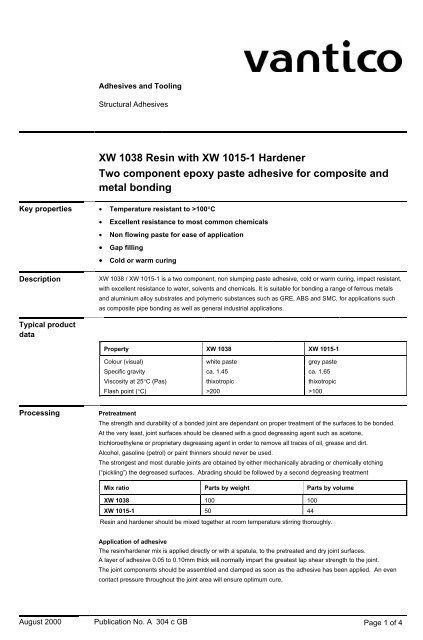
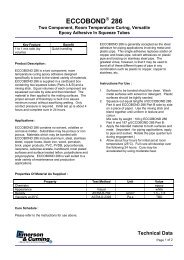
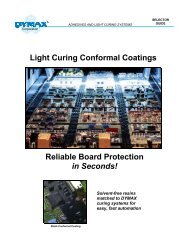

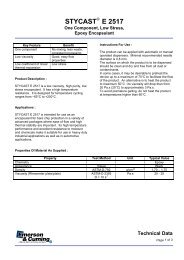
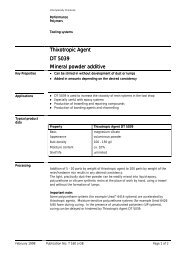
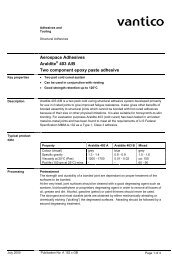
![[pdf] EXXON-TF56-TD - Lindberg & Lund AS](https://img.yumpu.com/52492677/1/190x245/pdf-exxon-tf56-td-lindberg-lund-as.jpg?quality=85)
